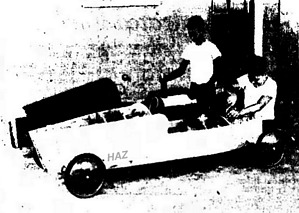| Guide | ♦ | 22 Triplogs | 0 Topics |
details | drive | no permit | forecast | route |
stats |
photos | triplogs | topics | location |
| 58 | 22 | 0 |
Derby Fever! by joebartels  Overview OverviewConnector trail between Max Delta Trail and the intersection of Ranger Trail and Los Lomitas Trail. Hike Easy to follow. A decent little trail if hiked at sunrise or sunset. Probably used most by mountain bikers that just happen to be in the area. This is ironic since they probably despise the nice ravines that give it character. Above the ravines, the tread was smooth and less sandy than anticipated. Appeared lightly used by horseriders, not destroyed like Los Lomitas or Box Canyon.
Years ago a good friend mentioned memories of soapbox races in the area. In an effort to feed my derby fever I spent a few days researching. Jump in for a ride... Racing! A soap box derby track on a nearby hill featured such guests as Pat McMahon, Wallace & Ladmo. Drivers aged 11 through 15 raced for an all-expenses-paid trip for the champion to the All American Soap Box Derby finals in Akron, Ohio ( run nationally since 1934 ). "Class A" groups are ages 13 to 15, and the "Class B" division is ages 11 to 12. The Jaycee Hall held clinics covering rules and explained design ideas. A picnic at Encanto Park was held the prior weekend. KPHO Channel 5 televised some of the events live. 1959 - Derby director Mike Kennelly, who built the original track, expected more than 100 participants in the race. The boys competed for $15,000 in college scholarships. The derby was under the direction of the Phoenix Junior chamber of commerce. Sponsors included Phoenix Chevrolet dealers and KOOL TV. Entries met rigid specifications and built their car for no more than $15. Official wheels and axles were $20 extra, apparently a standard. Car and driver weight was limited to 250 pounds. The race ran in three-car heats on a 600-foot derby track. 700 feet of stopping area was allowed. Speeds up to 26 mph were expected by the finish line. 1961 - Tucson Daily Citizen called the SoMo track "Jimmy Bryan Junior Speedway". Tucson boys won the 1960 series. In a letter to the editor, one Tucsonan had his feathers in a ruffle since a better-equipped track (closed) in Tucson lost sponsors due to a lack of participation and enthusiasm. 1963 - Wheel and steering kits were made available free of charge along with a sponsor for each car. The track was 682 feet and averaged 26 miles per hour. In addition to winning, trophies ranged from best upholstery to brake assemblies. Imagine tennis balls over axle assemblies for a suspension system. 1971 - Girls first entered the local derby! 1972 - Chevrolet, a division of General Motors, withdrew its sponsorship. 1973 - 62 boys and 7 girls competed. The national soapbox derby winner received a $7,500 scholarship. A total of $30,110 in scholarships was shared by the top nine national winners. Rules for the competition required carts to be built by the driver for $45 or less. Without a major sponsor, it was the beginning of the end... the lightest field in years. 1975 - 32 entries Check out the Official Route and Triplogs. Leave No Trace and +Add a Triplog after your hike to support this local community. One-Way Notice This hike is listed as One-Way. When hiking several trails on a single "hike", log it with a generic name that describes the hike. Then link the trails traveled, check out the example. | ||||||||||||||||||||||||||||||||||||||||||||||||||||||||||||||||||||||||||||||||||||||||||||||||||||||||||||||||||||||||||||||||||||||||||||||||||||||||||||||||
 Route Editor
Route Editor




